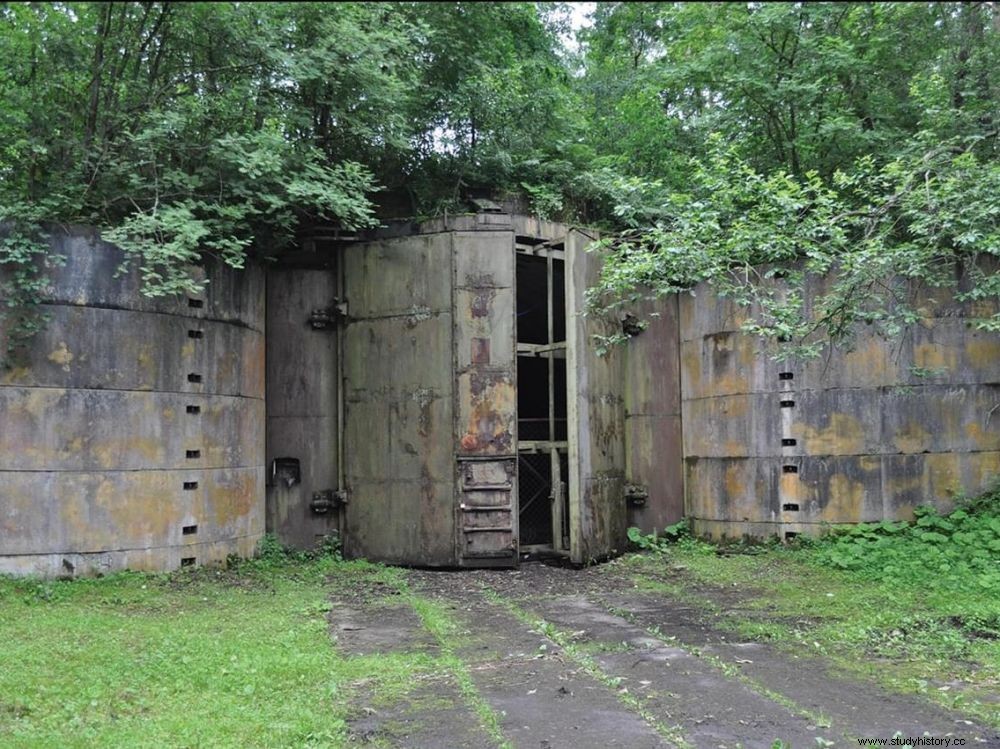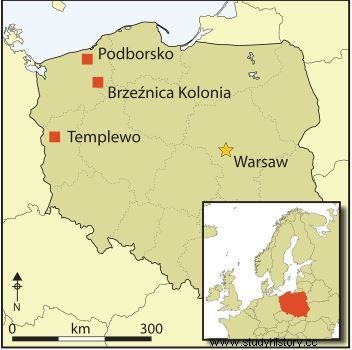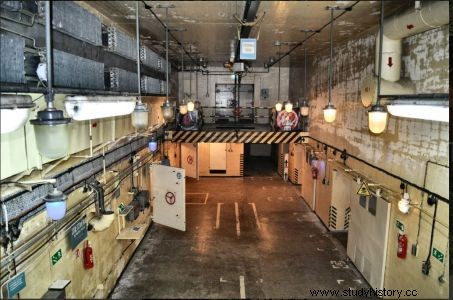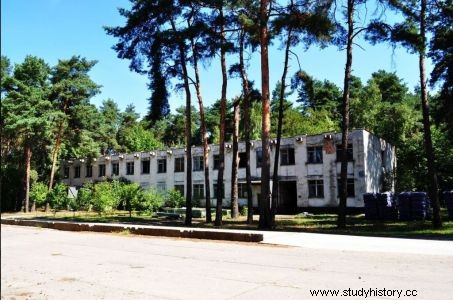A chilling legacy of the Cold War, an archaeologist has studied former Soviet bunkers in Poland that once housed nuclear warheads.

A remnant of the cold war, one of the granite bunkers in Podborsko, hidden under vegetation cover, in western Poland.
The archeology of contemporary conflict sites is on the rise. Whether it is about the two world wars of the 20th century, with in particular the Nazi concentration camps (like that of Natzweiler-Struthof, in Alsace or those of Sobibor and Treblinka, in Poland), archaeologists do not hesitate more to seize recent history to carry out their research. Including concerning the Cold War era (1945-1989), as Grzegorz Kiarszys, from the Polish Institute of History and International Relations, has just done. The young researcher was indeed interested in the bunkers that once housed Soviet nuclear warheads, now abandoned in the forests of western Poland, after their dismantling. Ancient secret bases that have been the subject of a detailed study published in the journal Antiquity .
 Remains of former Soviet military sites on Polish territory. Credits:Grzegorz Kiarszys
Remains of former Soviet military sites on Polish territory. Credits:Grzegorz Kiarszys
"Some nuclear warhead storage sites are still very well preserved"
To study these sites, Grzegorz Kiarszys used remote sensing techniques such as airborne laser scanning (ALS), analyzed aerial photographs and images declassified by the CIA* in 2006 from the Corona, Gambit and Hexagon programs. He also accessed the archives of the Institute of National Remembrance of Poland. This allowed him to reconstruct the organization of three military bases located in western Poland which, ceded to the Soviets in 1969, had disappeared from official archives….
 Poland:Location map of the three secret Soviet nuclear bases during the Cold War. Credits:Grzegorz Kiarszys
Poland:Location map of the three secret Soviet nuclear bases during the Cold War. Credits:Grzegorz Kiarszys
The aerial photos taken by the Polish cartographic services, from the end of the 1960s to the 1990s, had also been censored. Joined by Sciences et Avenir , the young researcher currently attached to the Department of Archeology at the University of Szczecin explains that he patiently explored each of these former nuclear warhead storage sites:"Some are very damaged, such as Brzeznica Kolonia, 15 km of Borne Sulinowo and Templewo, 17 km from Miedzyrzecz, dismantled in the 1990s; while others are still very well preserved ", explains Grzegorz Kiarszys. "The most impressive are the three bunkers in Podborsko, 35 km from Bialogard, where most of the original equipment is still in place! ".
 US spy satellite images of Soviet nuclear sites located in Poland during the Cold War. A) Podborsko; B) Kolonia Brzeznica; C) Templewo. Credits:US Geological Survey / Corona Program
US spy satellite images of Soviet nuclear sites located in Poland during the Cold War. A) Podborsko; B) Kolonia Brzeznica; C) Templewo. Credits:US Geological Survey / Corona Program
Armored doors, old empty silos - where the electricity still seems to be working -... the photos taken by Grzegorz Kiarszys are eloquent. "The archaeological study of these sites that were to disappear will be able to complete the historical narrative... It is exceptional to be able to study these places that have remained secret, hidden from society, then forgotten “, explains the researcher. New pages on the presence of Soviet bases in Poland will thus be able to be written.
 Current interior of the Monolit bunker in Podborsko, with its original furnishings. Credits:Grzegorz Kiarszys
Current interior of the Monolit bunker in Podborsko, with its original furnishings. Credits:Grzegorz Kiarszys
To understand the importance of this innovative research, it is indeed necessary to recall the reasons for which the leaders of the former USSR had taken the decision to build these bases in Poland.
 One of the four warhead storage rooms at the Podborsko military site in western Poland. Credits:Grzegorz Kiarszys
One of the four warhead storage rooms at the Podborsko military site in western Poland. Credits:Grzegorz Kiarszys
Secret facilities
"Military analysts of the Warsaw Pact (1955) had estimated that in the event of a conflict with NATO in Europe, the transfer of nuclear warheads from the Soviet Union would have taken too long. Not to mention the risk of their destruction by air attacks during transport. Therefore, it was decided to arrange in the greatest secrecy these three storage sites for these weapons* in the west of Poland. The code name of this operation being Wista" , adds Grzegorz Kiarszys. "Until then we thought that such bases were occupied by young soldiers, but our study shows that it was mainly NCOs and officers who were present on site with their families ".
Each secret installation had a garden and play areas. Found clothing and toys testify to a more complex social organization and the emphasis placed on welfare by the Soviet authorities so that the highly skilled engineers who lived there - those who handled weapons of mass destruction - had the conditions pleasant lives. "Soviet leaders were careful to place these weapons in the hands of psychologically stable personnel, which made it possible to house officers and their families in one military compound, creating the illusion of normal life ", believes Grzegorz Kiarszys. "Without this balance, these places could have created problems of insubordination ".
 Remains of buildings on one of the Soviet military bases in Poland. Credits:Grzegorz Kiarszys
Remains of buildings on one of the Soviet military bases in Poland. Credits:Grzegorz Kiarszys
All these bases were built on the same model, with an identical number of buildings, fortification trenches, shelters for vehicles, checkpoints (check-point ), etc. The same goes for the restricted access areas, with their nuclear warhead storage bunkers, - those of the "Monolit" type in the 1970s, and later "Granit". "In collaboration with nuclear physicists, we carried out radiation measurements in all the storage facilities. No radioactive pollution was detected. This indicates that all the warheads stored were within the standards of very strict security….or that some of these installations could have remained empty… ", ventures Grzegorz Kiarszys who could not access any Russian archives to verify these hypotheses.
 Remains of one of the warhead silos at the Brzeźnica-Kolonia site. Credits:Grzegorz Kiarszys
Remains of one of the warhead silos at the Brzeźnica-Kolonia site. Credits:Grzegorz Kiarszys
Today, these sites tend to become places of tourist attraction, for enthusiasts who wish to discover the material remains of one of Eastern Europe's best kept secrets during the Cold War. "Testimonials that deserve our full attention! "
 Credits:Grzegorz Kiarszys
Credits:Grzegorz Kiarszys
GLOSSARY
Warsaw Pact.
The Warsaw Pact is an old military alliance grouping the countries of Eastern Europe with the USSR in a vast economic, political and military whole. It was concluded on May 14, 1955 between most of the communist countries of the Soviet bloc by a treaty of friendship, cooperation and mutual assistance.
Cold War.
Period of ideological, geopolitical and economic confrontation which gradually took place between the United States and the USSR from the end of the Second World War (1945 to 1947) until the fall of the communist regimes in Europe in 1989, which were quickly followed by the breakup of the USSR in December 1991.
* During the Cold War, the Polish People's Army reportedly had 178 to 250 Soviet nuclear warheads.
*CIA:Central Intelligence Agency
*NATO:North Atlantic Treaty Organization
